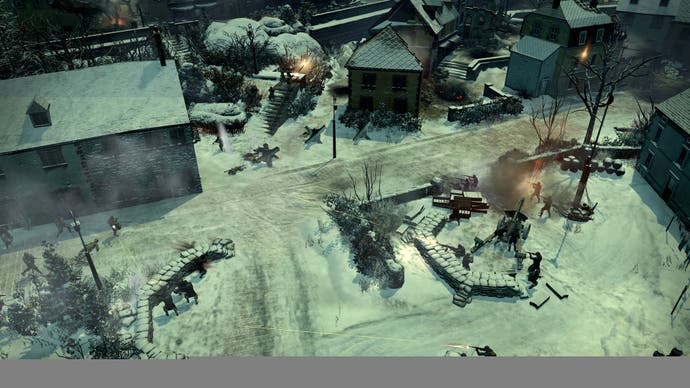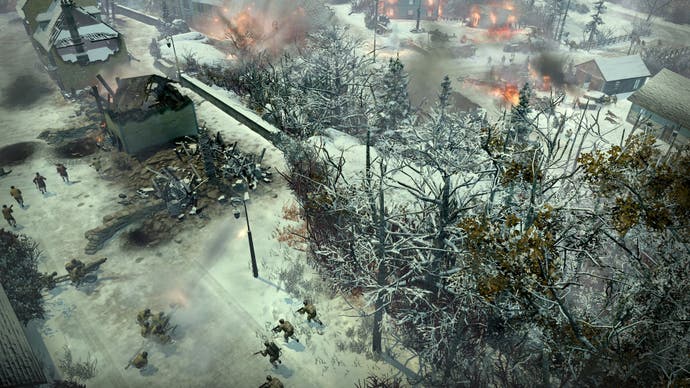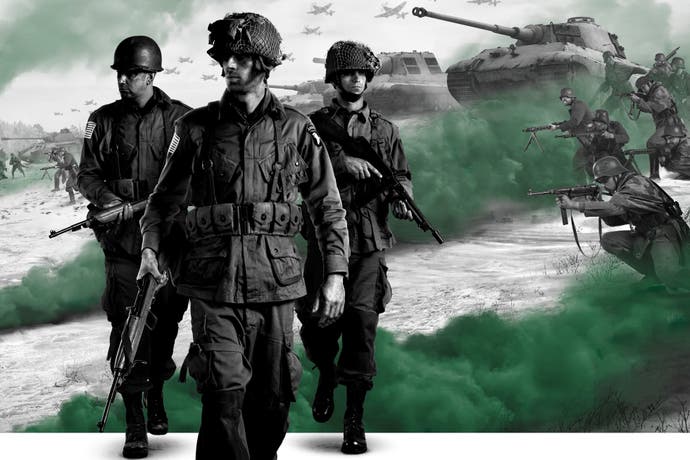Why variety is key for Company of Heroes 2: Ardennes Assault
Right up your war-torn street.
At the end of the campaign in any good strategy title there usually comes a warm fuzzy feeling of having triumphed against increasingly overwhelming odds. Sadly, this is often tinged with the knowledge that there's little reason to go back and repeat the experience. Some of those people take their fight online to battle against the tougher opposition of human intelligence but others simply drift away, moving on to a new, authored challenge elsewhere.
Company of Heroes 2: Ardennes Assault is aimed at giving the latter group a reason to return to the beginning; to fight the good fight using different tactics, different soldiers and to experience a different series of random events embedded in the story of three varied commanders. Like the troops it depicts, this single-player standalone expansion to Relic's 2013 RTS Company of Heroes 2 does this using a variety of different tactics.
The first is the companies themselves, of which game director Quinn Duffy recently gave an overview at EGX along with a practical demonstration of how the three differ in approach. You'll be utilising all three companies in any one game but must choose which to take into battle on a mission-by-mission basis. By promoting the use of the veterans of the Able Airborne Company, the vehicular strengths of the mechanised Baker Company and the bullish use of ordinance by the support-based Dog Company, the intention is to have them feel different enough that tackling the same missions with each will result in a naturally varied approach.

It works, too, or at least it did during the Houffalize mission, played three times over and successfully completed twice (sorry, Baker Company). This mission showed how Relic is mixing things up to take account of the different companies' strengths, with the veteran infantry of the airborne regiment able to snake between buildings and flush out soldiers and parachute-in reinforcements, while the mechanised troops focussed on manoeuvring their vehicles toward the objective up wider, but better defended roads. The aim is to offer players a chance to exploit the particular strengths of the company they've taken into any given battle but for things to feel fresh on a second or even third play through with another.
"Historically, we've always developed armies and campaigns simultaneously but there's a challenge in that because the armies are a moving target and the campaign constantly requires re-balance," explains game director, Quinn Duffy. "What this did was free up our campaign designers to try new things and push ahead with their design without worrying about what was changing with the armies, and I believe that helps deliver a more complete game."
This vision of completeness includes dynamic elements missing from previous single-player Company of Heroes campaigns. Multiple plays of the same level offered the chance to witness the randomised secondary objectives, such as rescuing a squad of soldiers holed-up in a house or hunting down and assassinating a German officer. The reward for completing these random missions is company bonuses, such as veternacy points or health boosts. They'll also yield additional requisition points that can be spent on any of your three companies to unlock additional commander abilities or bolster the health of the squad.
This last is important because Ardennes Assault offers a degree of persistence that sees each company gain experience and veteran status over time. Losing troops is of much greater import here that it was in the main game, as the loss of experienced troops will lower the overall veterancy of the company and damage its chances in future engagements. Going hand in hand with this persistent progression system is the development of each company's commanding officer, whose personalities will reflect how each adapts to the rigours of command as they come to terms with their role and that of the men under their instruction. Post-mission reports from each officer take account of your performance, how many missions they've undertaken and where they are in their own personal story arc and it's through these three men that the story of the Ardennes Assault, the so-called Battle of the Bulge, is ultimately told.

"The real focus early on was committing to this idea of player agency and keeping players involved in the story and in many ways driving the story," explains Duffy. "We thought that maybe there was a better way to tell their story in the context of this battle than a linear narrative and to give players a chance to involve themselves in that narrative.
"It's an interesting departure for us and it may portend the future or it may not but it wasn't necessarily a reaction to anything that we had done in the past; just a desire to do things in a unique way."
This necessitates a degree of artistic licence and Duffy is keen to stress that the historical events that began in December 1944 have inspired Ardennes Assault rather than being used as a blueprint for its narrative construction. However, there is a greater degree of effort being made to ground the events in a real world location and to depict how the allied forces moved through the region during the counter attack and this is where the Strategic Metamap comes into play.
Now, there's a reason that mention of the metamap has come so far down this page and that's because talking about a map is not the most interesting of topics, especially not one with so dry and uninspiring a title. However, the metamap of Ardennes Assault has the potential to offer additional randomised events into any given campaign and, as such, will offer that all-important variety on any future playthroughs. Constructed from a number of coloured regions delineating allied and enemy territory, you must select which region your companies will move through next as they make their way toward the next objective, as decided by you.
Each segment signifies an event of some description, perhaps a minor skirmish against German troops or an event that requires you to make a decision in a manner not entirely dissimilar to indie space-travel classic, FTL. These events will have either an immediate effect on your company's status or a longer term effect on a nearby mission, while successfully chasing out troops from one area may force them to help reinforce another. Sure, the metamap is little more than a random event generator, but its admirable that Relic is willing to adapt its approach to single-player campaign missions to that used in the main game and on those grounds this element of Choose Your Own Adventure is a welcome addition.
Spread over eighteen missions, four more than the original Company of Heroes 2 campaign, Ardennes Assault is intended as fully-fledged experience in its own right at a lower price than the main game. There are some questions over how welcoming it will be to new players and based on just one mission's play it's difficult to appreciate how well the random elements effect moment to moment play, but those willing to take up arms and join the counter-offensive will at least be offered a larger degree of choice and a greater potential for repeat play than Company of Heroes campaigners ever have in the past.
This preview comes from a press event in Brussels. Sega paid for travel.

